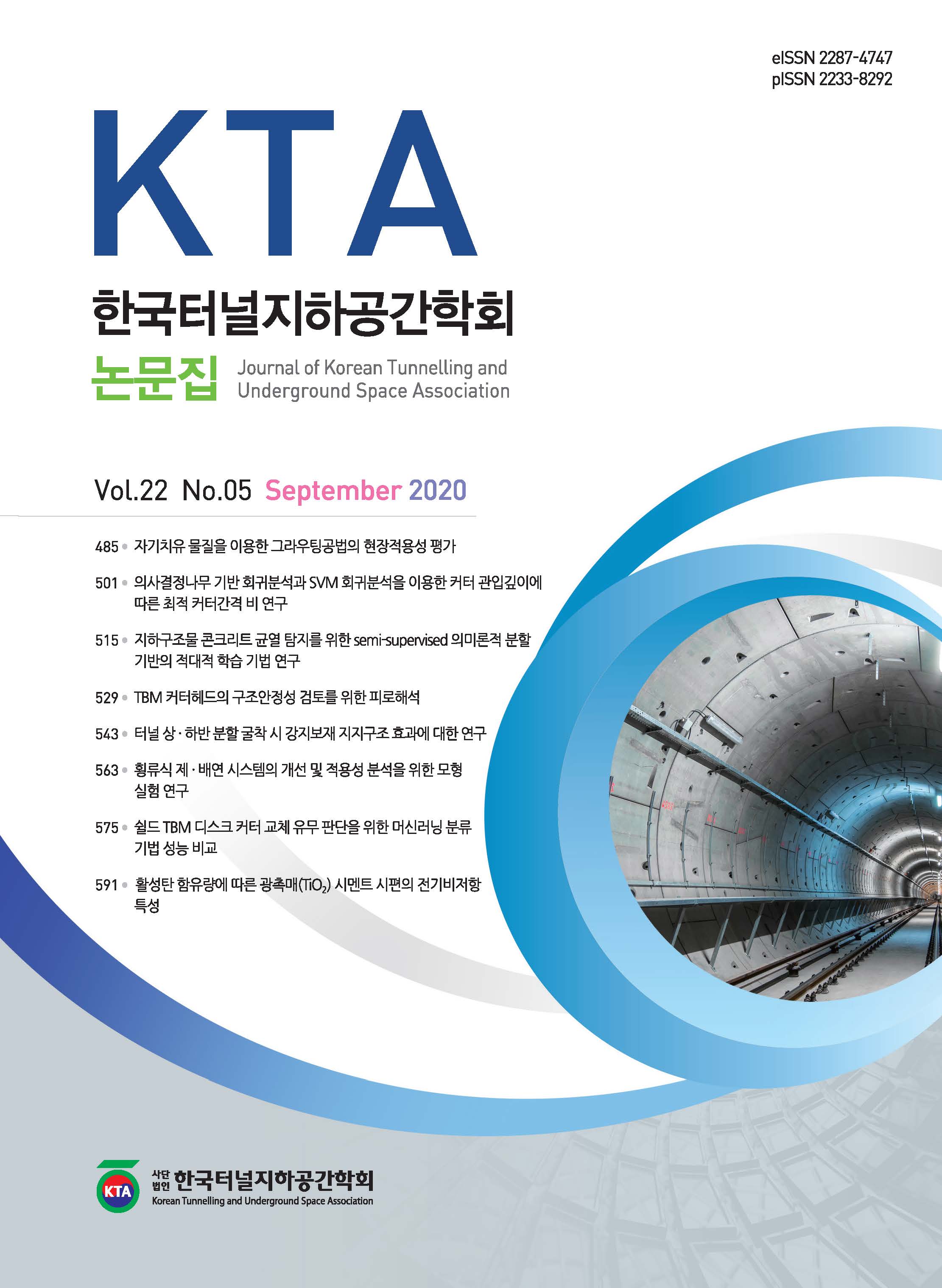(사)한국터널지하공간학회
- Log In/Sign Up
- P-ISSN2233-8292
- E-ISSN2287-4747
- KCI
 ISSN : 2233-8292
ISSN : 2233-8292
Article Contents
- 2024 (Vol.26)
- 2023 (Vol.25)
- 2022 (Vol.24)
- 2021 (Vol.23)
- 2020 (Vol.22)
- 2019 (Vol.21)
- 2018 (Vol.20)
- 2017 (Vol.19)
- 2016 (Vol.18)
- 2015 (Vol.17)
- 2014 (Vol.16)
- 2013 (Vol.15)
- 2012 (Vol.14)
- 2011 (Vol.13)
- 2010 (Vol.12)
- 2009 (Vol.11)
- 2008 (Vol.10)
- 2007 (Vol.9)
- 2006 (Vol.8)
- 2005 (Vol.7)
- 2004 (Vol.6)
- 2003 (Vol.5)
- 2002 (Vol.4)
- 2001 (Vol.3)
Improvement of RTL system for location monitoring of multi-laborers in the underground space
- Downloaded
- Viewed
Abstract
Real time location (RTL) system which can control the safety of laborers in the underground space is developed in this study. This innovative system can monitor the location and history of movement of multiple laborers in real time. To accommodate constrains of the underground space, the system is portable and composed with low-battery mode. Since conventional method to detect the location of laborer with radio signal strength indicator (RSSI) contains high errors, new measurement system using accelerometers and correction method are suggested in this study. Field test is performed to validate the developed system. The error for moving laborer was 0.4 m and for non-moving laborers was 0.2 m. Thus, it is found that the new RTL system can be used to monitor the location of laborers in the underground construction space.
- keywords
- Underground space, RTL system, RSSI, Accelerometer, 지하공간, 실시간 위치정보 시스템, 라디오주파수강도, 가속도계
Reference
1. Kim, D.W., Moon, S.M., Cho, H., Kang, K.I. (2011), “An application of safety management for tunnel construction using RTLS technology”, Korea Journal of Construction Engineering and Management, Vol. 12, No. 2, pp. 12-20.
2. Park, J.S., Lim, S.B., Pyeon, M.W., Hong, T.M., Lee, B.K. (2009), “Experiment of propagation for development of the RTLS to the construction site”, The Journal of the Korean Society of Surveying, Geodesy, Photogrammetry and Cartography, Vol. 27, No. 4, pp. 505-513.
3. Lee, J.K., Lee, T.H., Byun, J.H., Noh, Y.J. (2013), “A basic study on the applicability of the RTLS technology to construction site based on CSS”, Journal Of the Architectural Institute of Korea Structure & Construction, Vol. 29, No. 5, pp. 61-68.
4. Lee, H.S., Lee, K.P., Park, M.S., Kim, H.S., Lee, S.B. (2009), “A construction safety management system based on Building Information Modeling and Real-time Locating System”, Korea Journal of Construction Engineering and Management, Vol. 10, No. 6, pp. 135-146.
5. Oksar, Irfan. (2014), “A bluetooth signal strength based indoor localization method”, Systems, Signals and Image Processing (IWSSIP), 2014International Conference on IEEE.
6. Yoon, C.P., Hwang, C.G. (2015), “Efficient indoor positioning systems for indoor location-based service provider”, J. Korea Inst. Inf. Commun. Eng., Vol. 19, No. 6, pp. 1368-1373.
7. Kim, J.H., Joo, Y., Lee, S.G., Park, S.S., Seo, D.H. (2012), “Improvement of multilateration using vector prediction algorithm and kalman filter”, The Korea Institute of Information and Communication Engineering, Vol. 16, No. 12, pp. 2792-2799.
8. Nho, A., Lee, W.J. (2010), “Accuracy evaluation of ZigBee’s indoor localization algorithm”, Korea Society for Internet Information, Vol. 11, pp. 27-43.
9. Yeom, J.N., Lee, G.B., Park, J.J., Cho, B.J. (2009), “Position estimation system of moving object using GPS and accelerometer”, Journal of Korea Multimedia Society, Vol. 12, No. 4, pp. 600-607.
10. Kwon, S.R., Jung, K.J., Park, S.S., Kim, J.H., (2007), “RTLS technologic application for ubiquitous port management efficiency”, Korea Information Science Society, Vol. 13, No. 6, pp. 371-377.
- Downloaded
- Viewed
- 0KCI Citations
- 0WOS Citations
